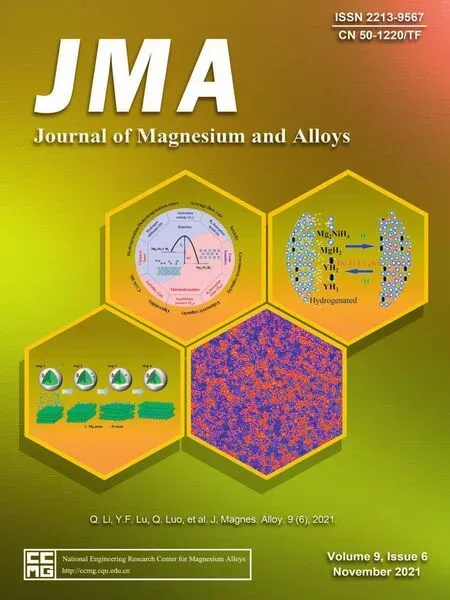Rapid-developing Mg-based biodegradable materials:The editorial of the special issue on Mg-based functional materials -biomaterials section
2021-04-09DiMei,ShaokangGuan
Since physician Edward C.Huse firstly tried to stop bleeding blood vessels with Mg wires in 1878 [1],the history of Mg and its alloys as biomaterials has gone through more than 140 years.Especially,in the latest 20 years,scientists from all over the world have carried out all-around research on Mg-based materials for the applications of vascular stents,bone fixation materials and other biodegradable implants.Although some gratifying progress has been obtained,the relatively high corrosion rate,the insufficient strength/toughness and difficulties in precision processing of Mg-based materials still limit their wide applications in the field of biomedical devices to a certain extent.Thus,the related research works are still widely carried out.
In recent two years,a number of works about Mg alloys for biomedical applications have been published in related journals.The topics that have received more attention mainly include the composition design of Mg alloys for biomedical applications[2–4],the structural design of Mg-based implants[5,6],the processing technology of Mg devices [7–9],Mgbased composite materials for biomedical applications [10–12],bio-functional surface treatment technology [13–15],in vitrodegradation behavior [16–20],and the service performance of Mg implants in animal trials and clinical treatment[21–24].
Thanks to the rapid development of Mg-based biomaterials,the editorial board of JMA,the only international academic journal in the world focusing on cutting-edge research related to Mg and its alloys,decided to provide a separate platform in this issue to introduce the latest progress in this field.We hope that the following brief introduction can help the readers quickly locate the papers of interest to them in this special issue.
Tsakiris et al.reviewed the development process of biodegradable Mg alloys for orthopedic implants applications.The degradation mechanism,surface modification technology,and the approaches for improving the corrosion resistance and mechanical properties of Mg and its alloys were comprehensively discussed.
Jia et al.and Kumar et al.introduced two advanced manufactory technologies,template replication of infiltration casting and ultrasonic assisted conventional sintering,for Mg alloys in the field of biodegradable implants.These works remind us to pay attention to the near-net shaping technologies,which can be employed to prepare the Mg-based implants with more complex structures.
Five original research articles in the field of the surface modification,one of the main hotspots for Mg research in biomedical applications,were included in this issue.Durán et al.prepared a multilayer barrier-bioactive hybrid sol-gel coating aiming at improving the corrosion resistance of Mg alloy and promotion ability of apatite products growth on the substrate.Mena-Morcillo et al.fabricated a MgF2/chitosan coating system on Mg alloy,which showed a noticeable antibacterial effect against Klebsiella Pneumoniae.Millán-Ramos et al.proposed a ZnO2coating system by reactive magnetron sputtering for improving the antibacterial effect of Mg alloys toS.aureus.Cheon et al.found that the tantalum(Ta)ion-implanted poly(ether imide)(PEI)coating enhanced the endothelial cell adhesion/proliferation and suppression of platelet adhesion/activation on Mg stents.Yao et al.modified the Mg surface to simultaneously improve the corrosion resistance in simulated body fluid(SBF)and microhardness by selective laser melting(SLM).
In this issue,four papers about thein vitroevaluation of the degradation and biological properties of Mg-based biomaterials were published.Krüger et al.introduced one quantitative approach to describe the homogeneity of biodegradable Mg-based implants by micro-computed tomography(μCT).Lotfpour et al.investigated the corrosion behavior of cast and extruded Mg-Zn-Cu alloys in SBF.Ghazizadeh et al.found that biodegradable Mg/HA composite exhibited more promising anti-corrosion properties and corrosion-fatigue resistance in the physiological environment than that of pure Mg.Wang et al.fabricated an amorphous PLLA-Mg65Zn30Ca5 composite that showed a promising application value in bone repair and tissue regeneration due to its high corrosion resistance and good biocompatibility.
In addition,Wang et al.employed the computer simulation method to investigate the influence of Zn content on the fibrinogen adsorption behavior in Mg-Zn alloy.Tie et al.evaluated the biodegradability and biocompatibility of Mg-Zn-Sr alloys in the ureteral environment by animal trials in the pig model.
The papers included in this special issue cover the popular research topics for Mg alloys in biomedical applications.These high-quality papers will undoubtedly lead readers to understand the latest developments in these fields deeply.Finally,we hope to give some views on the future research topics in the field of biomedical Mg alloys based on our research experience:
(1)Simulation-assisted/ big data-driven design of highperformance Mg-based biomaterial
Simulation/calculation methods,such as molecular dynamics simulations and first-principles calculations,have been widely used to predict the performance of materials.Big data-driven methods,such as machine learning,have also been shown the potential for high-efficiency materials design.These methods make it possible to customize Mg-based biomaterials precisely based on the requirements.
(2)Customized multifunctional coating technologies
It is of great research significance and practical application prospects to customize the multi-functionalized coating system based on the functional requirements of various implant purposes,instead of simply aiming at improving corrosion resistance of Mg alloys.For example,anticoagulant coatings on vascular stents and bone healingpromoting coatings on bone implants.
(3)Precision processing technology of Mg microtubes for vascular stent applications
At current stage,the technological bottleneck of Mg alloy microtubes processing restricts the development and applications of Mg vascular stents.Thus,the precision processing technologies of Mg microtubes are worth investing more efforts.
(4)The standardization of thein vitroevaluations and more efforts onin vivotrials
Thein vitrotests are of great importance at the initial developing stage of the biomedical implant devices.However,thein vitrotest protocols used to evaluate biodegradable Mg alloys are controversial.This leads to the lack of comparability of results between different research groups,which primarily affects the research collaboration in this field.It must be noted thatin vitroevaluations cannot replacein vivotrials,which are the GOLDEN indexes for evaluating the performance of implants.In any case,the community should pay sufficient attention toin vivotesting.
杂志排行
Journal of Magnesium and Alloys的其它文章
- Magnesium-Based Materials for Energy Conversion and Storage
- A special editor’s issue on Mg-based functional materials:Design and development
- Assessing the microstructure and in vitro degradation behavior of Mg-xGd screw implants using μCT
- A combination strategy of functionalized polymer coating with Ta ion implantation for multifunctional and biodegradable vascular stents
- Enhanced hydrogen generation from hydrolysis of MgLi doped with expanded graphite
- In vitro corrosion-fatigue behavior of biodegradable Mg/HA composite in simulated body fluid
